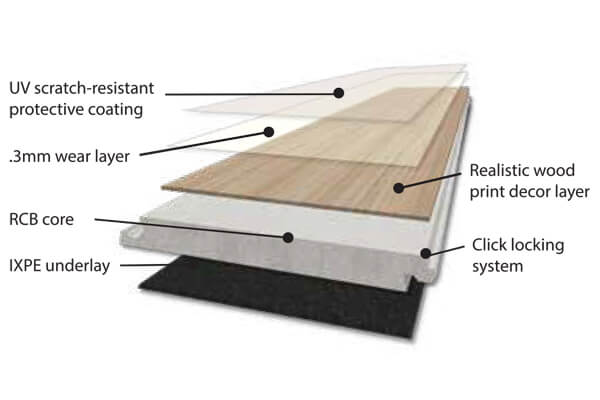Sapphire can be used and installed as a DIY product. Although we strongly recommend using a professional to make sure your subfloors and installation method are adequate to keep your warranty in order. Every box has the installation instructions on the back on the box. If you would like to view the instructions online please download them as a pdf.
PRE-INSTALLATION SUBFLOOR REQUIREMENTS
All Subfloors must be:
• Dry
• Clean: Thoroughly swept and free of all debris
• Structurally sound
• Level: Flat to 4.7mm per 3.3 meters radius
Wood sub-floors must be dry and well secured. Nail or screw every 15cm along joists to avoid squeaking. If not level,
sand down high spots and fill low spots with a leveling patch. Make sure all crawl space are open & has proper
ventilation.
Concrete subfloors must be fully cured, at least 60 days old, and should have a painted or 200 micron polyethylene
vapour barrier between concrete and ground. Subfloor should be flat and level within 4.7mm per 3.3 meters. If
necessary grind high spots down and level low spots with a leveling compound.
Ceramic Tile, resilient tile and sheet vinyl must be well bonded to subfloor, in good condition, clean and level. Do not sand existing vinyl floors, as they may contain asbestos.
Warning: Heating mats work very well under carpet, tile and stone; however, we do not recommend placing them directly underneath the Sapphire Tile floor. It is best to install Sapphire Tile flooring over embedded floor heating systems. Refer to manufacturer/distributor for installation & operating instructions.
Protection and Maintenance of Your Floor
Lasting beauty can be achieved through purchasing a quality floor covering and providing proper on-going
maintenance. Please follow the recommendations in this guide to retain the fresh look and protect the floor finish.
- After installation, we recommend a first cleaning to remove any loose dirt or debris that may have been caused during installation.
- Protect the floor surface from walked in abrasive dirt and debris by using a good walk on/off mat.
- Check any new cleaning agent on a small test patch of the floor in an inconspicuous area.
- Avoid using harsh cleaners or any cleaner with an ammonia base.
- Furniture should be moved onto the newly installed floor using an appliance hand truck over hardboard
runways, or pulled on towels/blankets into position and be fitted with felt pads to protect your flooring
surface.
- Avoid exposure to long periods of direct sunlight. Close blinds or drapes during peak sunlight hours.
- Natural ventilation or intermittent air conditioning in vacant/holiday homes should be used.
- Oil or petroleum-based products can result in surface staining.
- Use non-staining mats. Rubber will discolour the floor or cause it to turn yellow.
- Frequently moved furniture should be equipped with felt pads to avoid scratching the floor.
- Furniture with castors or wheels must be easy swivelling, large surface non-staining and suitable for resilient floors.
- Do NOT use ball type castors as they can damage the floor. For office chairs soft-wheeled castors must be used.
- Use felt floor protectors under furniture.
- Pets with unclipped nails may result in severe scratching to the floor surface. The same is true for any high/stiletto heeled shoes that do not have proper tips on the heels.
- Sweep or vacuum the floor regularly to remove loose dirt.
- Do NOT use vacuums that use a beater bar or turn
beater bar off.
- Do NOT use electric brooms with hard plastic bottoms with no padding.
- Clean up spills immediately.
- Do NOT use harsh cleaners or chemicals on the floor.
- Do NOT use abrasive scrubbing tools. Do NOT use detergents, abrasive cleaners or
“mop and shine” products.
- Vinyl Flooring, like other smooth floors, may become slippery when wet. Allow time for the floor to dry after washing. /li>
- If your floor has been exposed to excessive amounts of water due to flooding, do not panic, Sapphire vinyl is waterproof. Simply remove the water as quickly as possible. A de-humidifier should be promptly turned on in the room to reduce the moisture levels back to normal. Do not dry the room to below the normal moisture
level that existed previously.


